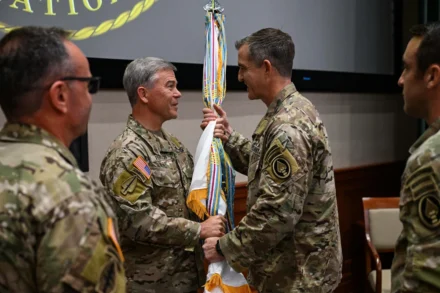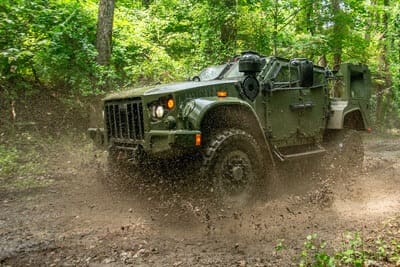FORT JOHNSON, La. — Amidst the evolving landscape of military acquisitions and the Army’s renewed commitment to agile, rapid capability development, the Next Generation Squad Weapon (NSGW) has undergone a pivotal Expeditionary Operational Assessment (EOA) in collaboration with elements of 1st Brigade, 101st Airborne Division (Air Assault), at the Joint Readiness Training Center (Rotation 25-07).
This assessment marks a significant step forward in the Army’s implementation of the continuous transformation framework, specifically within the Transformation in Contact (TiC) phase.

The 101st Airborne Division, identified by the Army as one of its TiC units, plays a critical role in rapidly integrating and evaluating emerging capabilities that directly address urgent operational requirements.
Operational Testing in TiC: A New Paradigm
The NGSW assessment at Fort Johnson is in direct response to Army Chief of Staff Gen. Randy George’s call to action for the Army to swiftly adapt its acquisition processes. Through the continuous transformation framework, TiC-designated units receive and rapidly implement new capabilities at a relevant speed. This has necessitated a shift in thinking from traditional test and evaluation (T&E) approaches, in trade for more agile, iterative processes. These highlight the integration of rigorous data-driven analysis and direct soldier feedback.
“Our commitment to providing world-class, objective test data to Army senior leaders remains unchanged. But the rapidly changing battlefield requires that we rethink historical methods and processes of operational testing. TiC especially highlights that we cannot remain in the status quo,” said Col. Mike Trotter, Director of the Maneuver Test Directorate (MTD), U.S. Army Operational Test Command (USAOTC). “We are embracing agility and broadening our testing horizons, while ensuring we retain world-class standards.”
Small Team, Big Impact
Whereas operational testing has traditionally been a large-scale effort — requiring extensive planning, coordination, and strict control of test variables — T&E within TiC has sparked more agile practices. EOAs are one such evolution.

This EOA event, which expands upon previous assessments conducted at Fort Campbell, Kentucky, is led by a specialized, nimble test team uniquely equipped for agile testing. The team is drawn from USAOTC’s MTD, Dismounted Test Division — Mr. Troy Willey, a retired Command Sergeant Major with extensive armored command experience; Mr. Bill Rabena, a mathematician, operations research systems analyst and former brigade commander with deep expertise in operational analytics; and Maj. Thomas Lorenson, the senior test officer. They are joined by Maj. Matt Brooks, a military evaluator from the U.S. Army Evaluation Center.
“The expertise of Mr. Willey and Mr. Rabena, as well as Maj. Brook’s operational experience, [are] invaluable,” emphasized Lorenson. “Their operational and analytical insights significantly enhance our ability to construe soldier feedback comprehensively and accurately. I’m fortunate to work alongside such a proficient and dedicated team of experts.”
Expanding the Testing Frontier
The broader shift toward EOAs was successfully applied in previous programs, such as the Infantry Squad Vehicle and Next Generation Tactical Vehicle. EOAs prioritize flexibility, mobility, and timely data collection within operationally realistic training and combat scenarios.
This EOA also reflects growing engagements between operational testers and the Combat Training Centers (CTCs). CTCs are uniquely poised to enable testers minimal, invasive access to TiC units in their training cycles. CTC conditions, in many cases, qualify as the operational realism required of traditional operational tests.
Col. Ricky Taylor, Commander of Operations Group at Joint Readiness Training Center, underscored this critical initiative. “We need to continue adapting to changes on the battlefield and replicate large-scale ground combat operations,” he said. “These assessments directly support the chief’s and the Army’s initiatives. It’s imperative we embrace them and fully integrate these assessors with our task force to achieve the most valuable operational data.”

Another key evolution was the integration with the Centers of Excellence (COE), as a source of evaluation criteria. This nascent approach seeks to align EOA data requirements with the learning demands of the COEs and, in some cases, the operational units. This marks a shift from traditional dependence on formal requirements documents, like the Capability Development Document, which may be outdated or absent in today’s rapidly evolving environment.
“The Army’s expectations are clear: operational testing must deliver timely, relevant insights without compromising rigorous evaluation,” explained Willey. “Our approach ensures rapid adaptation to soldier and unit needs, directly informing future capability development.”
Qualitative Insights, Quantitative Precision
During the assessment, the team conducts comprehensive qualitative and quantitative surveys with Soldiers, which captures broad perspectives on the NGSW’s 6.8mm ammunition, Fire Control System, and overall weapon implementation. Hundreds of Soldiers provide immediate, unfiltered insights highlighting both strengths and areas requiring improvement.
“The weapon is great. I can fire effectively from all positions, and it gives me a lot of confidence,” said Spc. Shaquille Pusey of Alpha Co., 1-506th Battalion. “My only issues are the bipod, which can be hard to manage, and the ammo pouch release button. It often comes undone when I move, spilling the link.”
“With this weapon, I’m simply more lethal,” said Sgt. Christopher Caldwell from 3rd Platoon, Alpha Co., 1-506th Battalion. “Engaging targets at long distances feels effortless. It’s like having a cheat code. The precision and controllability give us a clear edge.”
While qualitative soldier feedback provides firsthand experience, Rabena’s system-oriented approach ensures the rigorous analytical depth required in operational testing.
“Unique to this EOA is its targeted data collection approach, which focuses on specific areas needing improvement that were identified in a previous operational test’s database,” Rabena said. “This EOA serves as a litmus test for program manager (PM) progress and unit sentiment toward the new system. It essentially asks, what still needs to be fixed, and have any new issues emerged?” This structured data collection will yield precise, actionable feedback for evaluators like Brooks, who ensure system updates, while contributing to the iterative process.

“The Next Generation Squad Weapon program thrives on rapid prototyping and embedded evaluation,” said Brooks. “Soldier feedback drives iterative improvements at the speed of relevance, ensuring design adjustments meet real-world needs. The U.S. Army Evaluation Center accelerates the process by delivering results briefs to senior leaders within seven days of test completion.”
Unbiased Testing, Unchanged Integrity
While TiC assessments accelerate fielding timelines and challenge traditional test methodologies, USAOTC’s fundamental commitment to providing unbiased data for decision makers remains unchanged. Modernizing T&E capabilities and data collection methods, as well as fostering closer integration with new stakeholders across the acquisition and operational communities, enables the generation of critical insights under realistic operational conditions, free from personal bias.
“Our role as an impartial stakeholder is absolutely critical,” Lorenson noted. “We objectively report the data, bridging soldier experiences with the needs of program managers and the larger enterprise, ensuring rapid delivery of reliable and effective equipment.”
A Call to Action, A Call to Transform
The assessment at Fort Johnson directly aligns with the recent emphasis of Maj. Gen. John Klein, Special Assistant to the Commanding General, U.S. Army Training and Doctrine Command on incorporating lessons learned from global conflicts that highlight urgent operational realities. The continuous transformation framework, as demonstrated through TiC, ensures that soldier input, rigorous operational testing, and adaptive acquisition practices remain at the forefront of Army capability development.
“The Chief of Staff and Klein’s message to the force reemphasized the need to evolve iteratively and continuously,” said Rabena. “This assessment isn’t just about one weapon system. It represents the future of how we rapidly develop and field critical capabilities to Soldiers on the ground.”
Forward Momentum: Lessons and Insights
As the assessment concludes, USAOTC will produce a memorandum of observation highlighting critical improvements, agile spin-off opportunities, and valuable insights to guide ongoing and future acquisition efforts. By providing data-backed, field-tested insights, iterative feedback empowers both the developers and decision makers to innovate and deliver with the urgency of today’s battlefields demand.
“Our ultimate aim is timely feedback that enables PMs, Soldiers, and the broader acquisition community to swiftly and effectively deliver superior capabilities. The NGSW Expeditionary Operational Assessment at Fort Johnson exemplifies our commitment to transforming operational testing to meet the urgent demands of the modern battlefield,” concluded Lorenson.
“We are zealously looking at how we can assist meeting the demands of operational realities, continuous transformation, and the forthcoming sweeping changes across the Army Acquisition enterprise,” Trotter said. “What we do for our Army aids in providing the best equipment on the planet to our Soldiers so that they can fight, dominate, win, and survive on the battlefields in which they WILL find themselves. The NGSW EOA is a significant step forward in revolutionizing operational test and evaluation.”
By CPT Simeon Blakely, MAJ Thomas Lorenson, and Mr. Thomas Mort, Maneuver Test Directorate, U.S. Army Operational Test Command
Both comments and pings are currently closed.
Read the full article here








Leave a Reply